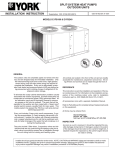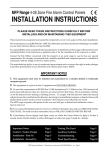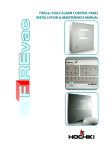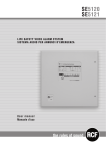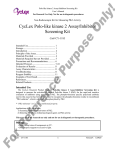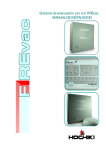Download 92-20522-89 Rev. 00 (-)PRL Series Installation
Transcript
START-UP AND PERFORMANCE Even though the unit is factory charged with Refrigerant-410A, the charge must be checked to the charge table attached to the service panel and adjusted, if required. At initial start-up or after extended shutdown periods, make sure the heater is energized for at least 12 hours before the compressor is started. (Disconnect switch on and wall thermostat off.) START-UP – CHECKING AIRFLOW The air distribution system has the greatest effect on airflow. The duct system is totally controlled by the contractor. For this reason, the contractor should use only industry-recognized procedures. The correct air quantity is critical to air conditioning systems. Proper operation, efficiency, compressor life, and humidity control depend on the correct balance between indoor load and outdoor unit capacity. Excessive indoor airflow increases the possibility of high humidity problems. Low indoor airflow reduces total capacity and causes coil icing. Serious harm can be done to the compressor by low airflow, such as that caused by refrigerant flooding. Heat pump systems require a specified airflow. Each ton of cooling requires between 375 and 450 cubic feet of air per minute (CFM). See the manufacturer’s spec sheet for rated airflow for the system being installed. Duct design and construction should be carefully done. System performance can be lowered dramatically through bad planning or workmanship. Air supply diffusers must be selected and located carefully. They must be sized and positioned to deliver treated air along the perimeter of the space. If they are too small for their intended airflow, they become noisy. If they are not located properly, they cause drafts. Return air grilles must be properly sized to carry air back to the blower. If they are too small, they also cause noise. The installers should balance the air distribution system to ensure proper quiet airflow to all rooms in the home. This ensures a comfortable living space. These simple mathematical formulas can be used to determine the CFM in a residential or light commercial system. Electric resistance heaters can use: CFM = EVACUATION AND LEAK TESTING EVACUATION PROCEDURE Evacuation is the most important part of the entire service procedure. The life and efficiency of the equipment is dependent upon the thoroughness exercised by the serviceman when evacuating air and moisture from the system. Air or nitrogen in the system causes high condensing temperatures and pressure, resulting in increased power input and non-verifiable performance. Moisture chemically reacts with the refrigerant and oil to form corrosive hydrofluoric acid. This attacks motor windings and parts, causing breakdown. g y • After the system has been leak-checked and proven sealed, connect the vacuum pump and evacuate system to 500 microns and hold 500 microns or less for at least 15 minutes. The vacuum pump must be connected to both the high and low sides of the system by connecting to the two pressure ports. Use the largest size connections available since restrictive service connections may lead to false readings because of pressure drop through the fittings. volts x amps x 3.413 SHC x temp rise Gas furnaces can use: Output Capacity in BTUH* SHC x temp rise *Refer to furnace data plate for furnace output capacity. SHC = Sensible Heat Constant (see table below), an air velocity meter or airflow hood can give a more accurate reading of the system CFM. The measurement for temperature rise should be performed at the indoor coil inlet and near the outlet, but out of direct line of sight of the heater element or heat exchanger. For best results, measure air temperature at multiple points and average the measurements to obtain coil inlet and outlet temperatures. CFM = Altitude (feet) Sea Level 500 1000 2000 3000 4000 5000 SENSIBLE HEAT CONSTANT (SHC) 1.08 1.07 1.05 1.01 0.97 0.94 0.90 ALTITUDE (FEET) 6000 7000 8000 9000 10000 15000 20000 • After adequate evacuation, open both service valves by removing both brass service valve caps with an adjustable wrench. Insert a 3/16” [5 mm] or 5/16” [8 mm] hex wrench into the stem and turn counterclockwise until the wrench stops. SENSIBLE HEAT CONSTANT (SHC) 0.87 0.84 0.81 0.78 0.75 0.61 0.50 92-20522-89-00 1 • At this time gauges must be connected to the access fitting on the liquid line (small) service valve and the common suction port connected to the common suction line between the reversing valve and compressor to check and adjust charge. IMPORTANT: Compressors (especially scroll type) should never be used to evacuate the air conditioning system because internal electrical arcing may result in a damaged or failed compressor. Never run a scroll compressor while the system is in a vacuum or compressor failure will occur. FINAL LEAK TESTING After the unit has been properly evacuated and service valves opened, a halogen leak detector should be used to detect leaks in the system. All piping within the heat pump, evaporator, and interconnecting tubing should be checked for leaks. If a leak is detected, the refrigerant should be recovered before repairing the leak. The Clean Air Act prohibits releasing refrigerant into the atmosphere. CHECKING REFRIGERANT CHARGE Charge for all systems should be checked against the Charging Chart inside the access panel cover. ! WARNING The top of the scroll compressor shell is hot. Touching the compressor top may result in serious personal injury. IMPORTANT: Use factory-approved charging method as outlined on the next 4 pages to ensure proper system charge. ! NOTICE The optimum refrigerant charge for any outdoor unit matched with a CFL/CFM/H*L indoor coil/air handler is affected by the application. Therefore, charging data has been developed to assist the field technician in optimizing the charge for all mounting configurations (UF – Upflow, DF – downflow, LH – Left Hand Discharge, and RH – Right Hand Discharge). Refer to the charging chart inside the access panel cover on the unit and choose the appropriate column for the specific application being installed or serviced. New installations utilizing either a CFL/CFM indoor coil installed on a gas furnace or an H*L air handler in the downflow or horizontal right hand discharge may require removal of refrigerant since the factory charge could result in an overcharge condition. CHARGING UNITS WITH R-410A REFRIGERANT ! CAUTION R-410A pressures are approximately 60% higher (1.6 times) than R-22 pressures. Use appropriate care when using this refrigerant. Failure to exercise care may result in equipment damage or personal injury. Charge for all systems should be checked against the Charging Chart inside the access panel cover. IMPORTANT: Do not operate the compressor without charge in the system. Addition of R-410A will raise high-side pressures (liquid, and discharge). 2 92-20522-89-00 ! NOTICE System maintenance is to be performed by a qualified and certified technician. The following method is used for charging systems in the cooling and heating mode. All steps listed should be performed to insure proper charge has been set. For measuring pressures, the service valve port on the liquid valve (small valve) and the service port on the suction line between the reversing valve and compressor are to be used. CONFIRM ID AIR FLOW & COILS ARE CLEAN Confirm adequate Indoor supply air flow prior to starting the system. See the Technical Specification sheet for rated air flow for each ID/OD unit match. Air filter(s) and coils (indoor & outdoor) are to be clean and free of frost prior to starting the system. Supply Air flow must be between 375 and 450 cfm per rated cooling ton prior to adjusting system charge. If a humidification system is installed disengage it from operating prior to charge adjustment. Refer to the “Checking Airflow” section of this manual for further instruction. ! NOTICE Verify system components are matched according to the outdoor unit Specification Sheet. MEASUREMENT DEVICE SETUP Step 1. With an R410A gauge set, attach the high pressure hose to the access fitting on the liquid line (small) service valve at the OD unit. Step 2. Attach the low pressure hose to the common suction port connected to the common suction line between the reversing valve and compressor. Step 3. Attach a temperature probe within 6” outside of the unit on the copper liquid line (small line). For more accurate measurements clean the copper line prior to measurement and use a calibrated clamp on temperature probe or an insulated surface thermocouple. CHARGING BY WEIGHT ! NOTICE ADJUST THE SYSTEM CHARGE BY WEIGHT FOR THE STRAIGHT LENGTH OF THE REFRIGERANT LINE SET. For a new installation, evacuation of interconnecting tubing and indoor coil is adequate; otherwise, evacuate the entire system. Use the factory charge shown in “Electrical and Physical Data” on page 7 of these instructions or on the unit data plate. Note that the charge value includes charge required for 15 ft. [4.6 m] of standard-size inter-connecting liquid line without a filter drier. Calculate actual charge required with installed liquid line size and length using: 1/4” [6.4 mm] O.D. = .3 oz./ft. [8.5 g/.30 m] 5/16” [7.9 mm] O.D. = .4 oz./ft. [11.3 g/.30 m] 3/8” [9.5 mm] O.D. = .6 oz./ft. [17.0 g/.30 m] 1/2” [12.7 mm] O.D. = 1.2 oz./ft. [34.0 g/.30 m] Add 6 oz. for field-installed filter drier. With an accurate scale (+/– 1 oz. [28.3 g]) or volumetric charging device, adjust charge difference between that shown on the unit data plate and that calculated for the new system installation. If the entire system has been evacuated, add the total calculated charge. IMPORTANT: Charging by weight is not always accurate since the application can affect the optimum refrigerant charge. Charging by weight is considered a starting point ONLY. Always check the charge by using the charging chart and adjust as necessary. CHARGING BY LIQUID SUBCOOLING MUST BE USED FOR FINAL CHARGE ADJUSTMENT. ! NOTICE The refrigerant pressures provided are for gross charge check ONLY. These pressure values are typical, but may vary due to application. Evaporator (indoor coil in cooling mode / outdoor coil in heating mode) t load will cause pressures to deviate. Notice that all systems have unique pressure curves. The variation in the slope and value is determined by the component selection for that indoor/outdoor matched system. The variation from system to system seen in the table is normal. The values listed are for the applicable indoor coil match ONLY! Step 4. If the measured liquid pressure is below the listed requirement for the given outdoor and indoor conditions, add charge. If the measured liquid pressure is above the listed requirement for the given Outdoor and Indoor conditions remove charge. FINAL CHARGE BY SUB-COOLING With thermostat in the “Off” position, turn the power on to the furnace or air handler and the heat pump. Start the heat pump and the furnace or air handler with the thermostat. Verify that the outdoor unit is operating in second stage and the indoor air mover is delivering the second-stage airflow for the system size. GROSS CHARGING BY PRESSURES Step 1. Following air flow verification and charge weigh in, run the unit for a minimum of 15 minutes prior to noting pressures and temperature. IMPORTANT: Indoor conditions as measured at the indoor coil must be within 2°F of the following during gross charge (pressure) evaluation: Cooling Mode: 80°F Dry Bulb Heating Mode: 70°F Dry Bulb ! NOTICE If the Indoor temperature is above or below this range, run the system to bring the temperature down or run the electric heat/furnace to bring the temperature within this range. System pressure values provided in the Charge Chart for outdoor dry bulbs corresponding to conditions outside of ranges listed below, are provided as reference ONLY. Step 2. Note the Outdoor Dry Bulb Temperature, ODDB°F = _______°F. Unit charging is recommended under the following outdoor conditions ONLY: Cooling Mode ONLY: 55°F outdoor dry bulb and above Heating Mode ONLY: Between 40°F and 60°F outdoor dry bulb Step 3. Locate and note the design pressures. The correct liquid and vapor pressures are found at the intersection of the Installed system and the outdoor ambient temperature on the Charging Chart located on the inside of the control box cover of the outdoor unit. Liquid Pressure: = ______psig; Vapor Pressure = ______psig Step 1. After gross charging note the designed Sub-Cool value. The correct sub-cooling value is found at the intersection of the Installed system and the outdoor ambient temperature on the Charging Chart located on the inside of the control box cover of the outdoor unit. SC° from Charging Chart = _________°F. IMPORTANT: Indoor conditions as measured at the indoor coil are required to be between 70°F and 80°F dry bulb for fine tune unit charge adjustment. Unit charging is recommended under the following outdoor conditions ONLY: Cooling Mode ONLY: 55°F outdoor dry bulb and above Heating Mode ONLY: Between 40°F and 60°F outdoor dry bulb ! NOTICE If the Indoor temperature is above or below the recommended range, run the system to bring the temperature down or run the electric heat/furnace to bring the temperature up. System sub-cooling values provided in the Charge Chart for outdoor dry bulbs corresponding to conditions outside of the above range, are provided as reference ONLY. Step 2. Note the measured Liquid Pressure, Pliq = ______psig, as measured from the liquid (small) service valve. Use the pressure temperature chart below to note the corresponding saturation temperature for R410A at the measured liquid pressure. Liquid Saturation Temperature, SAT°F= _________°F. Step 3. Note the liquid line temperature, Liq° = __________°F, as measured from a temperature probe located within 6” outside of the unit on the copper liquid line (small line). It is recommended to use a calibrated clamp on temperature probe or an insulated surface thermocouple. Step 4. Subtract the liquid line temperature (Step 3) from the saturation temperature (Step 2) to calculate SubCooling. SAT°F______ - Liq°______ = SC°_______ 92-20522-89-00 3 SATURATION TEMP (Deg. F) -150 -140 -130 -120 -110 -100 -90 -80 -70 -60 -50 -40 -35 R-410A PSIG 0.4 5.1 10.9 14.2 SATURATION TEMP (Deg. F) -30 -25 -20 -15 -10 -5 0 5 10 15 20 25 30 R-410A PSIG 17.9 22 26.4 31.3 36.5 42.2 48.4 55.1 62.4 70.2 78.5 87.5 97.2 Step 5. Adjust Charge to obtain the specified sub-cooling value. If the measured sub-cool is below the listed requirement for the given outdoor and indoor conditions, add charge. If the measured sub-cool is above the listed requirement for the given outdoor and indoor conditions remove charge. ! NOTICE Systems should not be fine tune charged below 40°F outdoor dry bulb. IMPORTANT: Excessive use of elbows in the refrigerant line set can produce excessive pressure drop. Follow industry best practices for installation. Installation and commissioning of this equipment is to be preformed by trained and qualified HVAC professionals. For technical assistance contact your Distributor Service Coordinator. 4 92-20522-89-00 SATURATION TEMP (Deg. F) 35 40 45 50 55 60 65 70 75 80 85 90 95 R-410A PSIG 107.5 118.5 130.2 142.7 156.0 170.1 185.1 201.0 217.8 235.6 254.5 274.3 295.3 SATURATION TEMP (Deg. F) 100 105 110 115 120 125 130 135 140 145 150 R-410A PSIG 317.4 340.6 365.1 390.9 418.0 446.5 476.5 508.0 541.2 576.0 612.8 FINISHING UP INSTALLATION • Disconnect pressure gauges from pressure ports; then replace the pressure port caps and tighten adequately to seal caps. Do not over tighten. • Replace the service valve caps finger-tight and then tighten with an open-end wrench adequately to seal caps. Do not over tighten. • Replace control box cover and service panel and install screws to secure service panel. • Restore power to unit at disconnect if required. • Configure indoor thermostat per the thermostat installation instructions and set thermostat to desired mode and temperature. CM 0312





